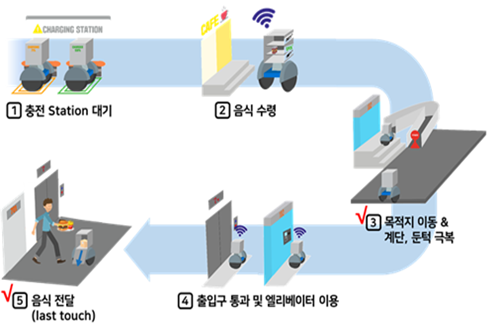Self-driving delivery robot service
business overview
| Project Title | Self-driving delivery robot service | ||
|---|---|---|---|
| company name | Mobin Co., Ltd. | ||
| Department in charge | Ministry of Land, Infrastructure, and Transport | Regulatory Department | Personal Information Protection Committee
National police agency Ministry of Interior and Safety |
| type of exception | Smart demonstration project | service type | 로봇 |
| Approval date | 2022-08-31 | Business start date | 2023-03-20 |
| Main Content | Overcome obstacles and provide delivery service using Baedalbok | ||
| Regulatory exceptions (Related regulations) |
|
||
| Additional conditions | ㅇ Regarding allowing delivery robots to walk on sidewalks | ||
① Securing standards for ensuring pedestrian safety (indoor safety test)
② Clear demonstration course designation
③ Ensuring sufficient width of the sidewalk
④ Maintenance such as road surface repavement for poor road surfaces and maintenance of high sidewalks
⑤ Designation of field personnel and drivers
⑥ Installation of information placards in major sections of the demonstration special case
⑦ Attach a sign to the outside that can confirm that it is an outdoor autonomous driving robot
|
|||
| ㅇ Permission to provide self-driving delivery robot services | |||
⑧ Attach a sign to the outside to identify an outdoor self-driving robot.
⑨ When using a sidewalk (walkway), designate a demonstration course only in places where sufficient sidewalk width is secured so as not to interfere with the passage of other pedestrians. ⑩ As the number of smartphone users increases while walking, there is a risk of collision accidents with the demonstration driving robot. Therefore, signs and voice warning facilities should be installed so that pedestrians can easily identify the demonstration driving robot.
⑩ As the number of smartphone users increases while walking, there is a risk of collision accidents with the demonstration driving robot. Therefore, signs and voice warning facilities should be installed so that pedestrians can easily identify the demonstration driving robot.
⑪ When driving in a protected area, set the driving speed in consideration of the transportation vulnerable who walk at slow walking speeds.
⑫ Safety personnel are required to be accompanied during demonstration driving and insurance is required to prepare for collision accidents between pedestrians and robots. ⑬ If a pedestrian safety accident occurs due to the verification drive, the verification drive is immediately stopped. ⑭ To ensure the safety of the robot, verification begins after indoor safety testing through the Robot Industry Promotion Agency. |
|||
| ㅇ Permission to film mobile imaging devices while driving the robot | |||
| ⑮ Videos captured by self-driving robots will be de-identified so that specific individuals cannot be identified and used only for the purpose of this demonstration project (Article 3, Paragraph 7 of the Personal Information Protection Act)
⑯ Information boards shall be installed and attached so that all information subjects, such as pedestrians, can easily understand the operating time and location of the self-driving delivery robot, the shooting range and purpose, and the method of processing the captured video, etc. (Article 15 (1) of the Personal Information Protection Act) , Article 25 Paragraph 4) ⑰ Personal information (personal video, vehicle number, etc.) among the videos captured by the self-driving delivery robot shall be deleted without delay after delivery and shall not be transmitted externally or stored separately ((Personal Information Protection Act Article 21, Standard Personal Information Protection) Guidelines Article 10)
⑱ In cases where video is to be used for the advancement of autonomous driving and deep learning, when time, cost, technology, etc. are reasonably considered, anonymization is done so that individuals can no longer be identified even when combined with other information (the original is processed after a high level of de-identification processing). Destruction) (Article 58-2 of the Personal Information Protection Act) ⑲ Cameras installed on self-driving delivery robots must not be arbitrarily manipulated for purposes other than the original purpose or directed to other places, and recording functions cannot be used (Article 25 (5) of the Personal Information Protection Act). ⑳ Establish a ‘personal information processing policy’ and make it public through the website, etc., implement safety measures such as encryption of transmission and reception, establish an internal management plan, and designate a protection manager, and establish a management and supervision system (Article 29 of the Personal Information Protection Act) , Articles 30, 31) ㉑ Comply with the protection principles and measures for safe management in accordance with the Personal Information Protection Act, and actively cooperate when requested by the Personal Information Committee to check whether this verification project is being faithfully implemented in the future. |
|||
| concept diagram |  |
||
담당자
| Department in charge | Ministry of Land, Infrastructure, and Transport | Urban Economics Department | 044-201-4842 |
|---|---|---|---|
| Regulatory Department | - | - | - |
| Dedicated organization | Korea Agency for Infrastructure Technology Advancement (KAIA) | Smart City Industry Support Center | 031-389-3619 |



